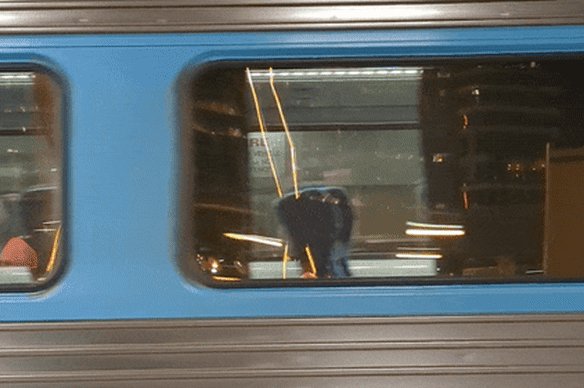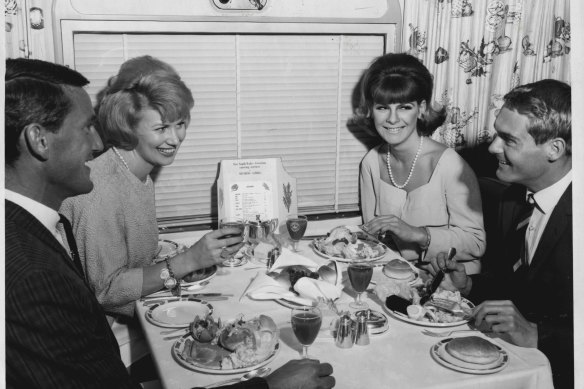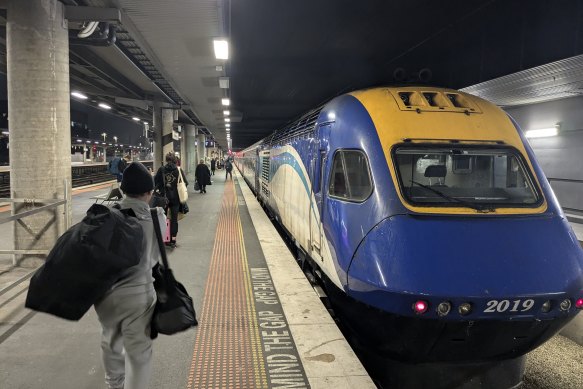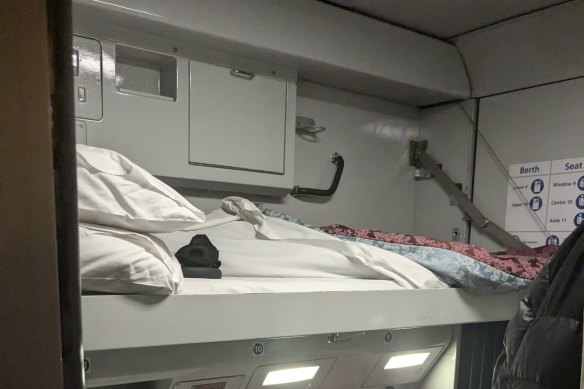By Liam Mannix
Examine, a free weekly newsletter covering science with a sceptical, evidence-based eye, is sent every Tuesday. You’re reading an excerpt – sign up to get the whole newsletter in your inbox.
A few weeks ago, overnight bag in hand, I strolled into Southern Cross Station to test a solution to the climate crisis.
Australians take more than 9 million flights between Melbourne and Sydney a year – each trip emitting about 71 kilograms of greenhouse gases.
It’s really, really hard to cut those emissions. The obvious solution: take the train.

Melbourne to Sydney via sleeper train: a climate crisis solution?Credit: Liam Mannix
Sleeper trains run every night between Melbourne and Sydney. You go directly from city centre to city centre. At $250, it’s competitive. You can take 45 kilograms of luggage. And it doesn’t matter that it’s slow because you’re asleep.
But as I stepped on board, I discovered that sleeper trains are like many potential Australian climate crisis solutions – they just don’t quite work yet.

Dinner on the Southern Aurora, seen in this photo from 1966.Credit: Fairfax Media
In The Ministry for the Future, author Kim Stanley Robinson imagines a post-net-zero world of travel by boat or train. It takes longer, but it’s much more comfortable, and you can stretch out and do work while travelling. In his prose, it sounds serene.
Forty years ago, the Southern Aurora and Spirit of Progress ferried 12 first-class sleeper carriages between Melbourne and Sydney each night. Dinner was a suit, pearls and champagne affair. Compare that with the ritual self-humiliation of 21st-century budget air travel.
Driven by environmental concerns – and perhaps a growing loathing of Ryanair – sleeper trains are enjoying a revival in Europe.
And there’s strong demand here – Melbourne-to-Sydney sleeper beds book out far in advance.

My XPT, about to depart Southern CrossCredit: Liam Mannix
Overall yearly patronage is about 300,000 – up 26 per cent from last year. The service is “pretty much at capacity”, says NSW TrainLink chief executive Roger Weeks.
In Australia, our transport strategies focus on electric cars, says Climateworks transport program lead Helen Rowe. The low-hanging fruit in decarbonisation is “getting the best use of existing services”, such as train travel. If we can get it right.
Perhaps the biggest advantage of the train is that it leaves from Southern Cross station. I caught a tram in, grabbed some overnight snacks from the supermarket, and then hopped on the train for a work-paid trip for a science conference. No checking in, no security lines, no wasting time getting to the airport early. So easy.
On board, my cabin was comfortable and spacious, with a large couch to stretch out on. I was greeted with a small box of snacks (water, crisps, biscuits), a soft towel for the hot shower and a small toiletries pack. A conductor popped in to say hi and check we had everything we needed. When the curtains closed and the train started chugging, it all felt a little Orient Express.

To sleep, perchance to dream.Credit: Liam Mannix
When my fellow traveller and I were ready, the conductor returned to convert our couch into a pair of bunk beds. The mattresses were firm and long enough to accommodate my long legs. There’s butter chicken or mac and cheese for dinner, and cereal and coffee for breakfast.
I flipped open my laptop to watch Netflix and ran into the first big problem: no WiFi and no mobile reception. I can’t watch a film. I can’t even check my emails.

Your correspondent.Credit: Liam Mannix
Problem two: the ride is bumpy, and stops frequently. I sleep well, but a lighter sleeper might struggle.
And problem three, which is probably the killer: we arrive in Sydney at 8.45am, almost two hours behind schedule. The trip has taken more than 12 hours – three hours longer than if I had driven.
My trip emits about half the greenhouse gases a flight would. And I end up showered and fed at Sydney Central, not a $30 Uber ride from the CBD.
But even the most ardent fans of rail travel admit the present service is just not competitive with air travel.
“It needs to be a lot faster than what it is now,” says John Hearsch, president of the Rail Futures Institute. “And it also needs to have many of the amenities that people in Europe have come to enjoy.”
The Melbourne to Sydney route was built in the days of steam travel. The locomotives had to avoid hills, so the track meanders – making it longer and slower. The XPTs that run on it are high-speed trains designed to reach speeds of 200km/h, but never get past 140km/h.
You could shave two hours off the journey by unwinding the track – at a cost of $6 billion, estimates Hearsch. Big money, but nothing compared with the $114 billion bill for a proposed high-speed rail. The Albanese government has established the High Speed Rail Authority to plan and develop a business case for a high-speed network connecting Melbourne and Brisbane, starting with very fast trains between Sydney and Newcastle. But progress has been painfully slow, while roads get most of the attention.
“Governments have spent tens of billions of dollars building the Hume Highway over many years. But virtually nothing was done to the railway that would have achieved a similar result,” says Hearsch.
Improving the track between Melbourne and Sydney would benefit freight as well. Philip Laird has argued in The Conversation that billions of federal dollars to modernise the Hume has had the effect of diverting freight away from rail and onto polluting diesel trucks; just 1 per cent of that huge freight route now runs on rail.
At least fixes to the carriages are coming. NSW has invested in a new 29-train electric-capable fleet that will further cut emissions – and has WiFi. But there’s no sleeper service.
That seems like a backwards step to me. My colleague Ben Grubb tried the sit-up overnight service and struggled to sleep.
That, to me, seems to sum up sleeper travel in Australia: a huge missed opportunity, due to a lack of joined-up thinking.
“Rail will definitely make a comeback,” says Hearsch. “But it’s going to take a lot of time and money.”
Enjoyed Examine, our free weekly newsletter covering science with a sceptical, evidence-based eye? Sign up to get the whole newsletter in your inbox.